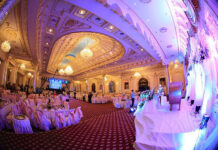Colors have been an integral part of human culture for millennia, serving as symbols of power, spirituality, and emotional states across diverse civilizations and eras. From the vibrant hues of ancient Egyptian tomb paintings to the symbolic reds and golds of Chinese imperial architecture, colors carry profound meanings that influence perceptions and behaviors. In recent decades, the intersection of traditional Feng Shui principles and contemporary design has further emphasized the significance of color in shaping environments that promote harmony, prosperity, and well-being.
Contents
- Fundamental Concepts of Color in Feng Shui
- Modern Design Perspectives on Color Application
- Educational Power of Colors: Cultural and Historical Insights
- Case Study: Unlocking Prosperity with Color
- Colors in Artifacts and Structures
- Non-Obvious Dimensions of Color
- Practical Guidelines for Color Use
- Future Trends in Color and Design
- Conclusion
1. Introduction: The Significance of Colors in Feng Shui and Modern Design
Colors are universal conveyors of meaning, deeply embedded in cultural narratives and personal experiences. Across civilizations, specific hues have symbolized power, spirituality, and social status. For example, in ancient China, yellow was reserved for the emperor, symbolizing authority and divine power, while in Western cultures, purple historically indicated nobility and wealth. These associations persist today, influencing how we select and interpret colors in our environments.
Traditional Feng Shui, an ancient Chinese system of spatial harmony, emphasizes the strategic use of colors aligned with the five elements—wood, fire, earth, metal, and water—to balance energy or qi. Modern interior design, on the other hand, often leverages color psychology to evoke specific moods—calmness, excitement, focus—and to influence consumer behaviors in commercial spaces. The convergence of these perspectives creates a rich tapestry where ancient symbolism informs contemporary aesthetics, providing a holistic approach to environment design.
This article aims to explore how understanding the power of colors can enhance personal well-being and prosperity. We will examine traditional principles, contemporary practices, and practical applications, illustrating these concepts with real-world examples such as the innovative use of color in modern game design, exemplified by the Fortune Gems 500.
2. Fundamental Concepts of Color in Feng Shui
a. The Five Elements and Their Associated Colors
Feng Shui is rooted in the theory of five elements: Wood, Fire, Earth, Metal, and Water. Each element is associated with specific colors that influence energy flow:
| Element | Associated Colors |
|---|---|
| Wood | Green, Brown |
| Fire | Red, Purple, Orange |
| Earth | Yellow, Beige, Brown |
| Metal | White, Gold, Silver |
| Water | Blue, Black |
b. How Colors Influence Energy Flow and Harmony
Colors in Feng Shui are believed to modulate the flow of qi, promoting balance and harmony. For example, activating the Fire element with reds and oranges can energize a space and stimulate passion or creativity. Conversely, calming blues and greens associated with Water and Wood can foster tranquility and renewal. Strategic placement of these colors influences the overall environment, aligning it with desired energies.
c. The Psychological and Emotional Effects of Different Colors
Research indicates that colors evoke specific emotional responses. Red can increase energy and excitement but also induce stress if overused. Blue tends to promote calmness and focus, while yellow can boost optimism and warmth. Understanding these effects helps in designing spaces that support mental health and productivity, demonstrating how traditional symbolism aligns with modern psychological insights.
3. Modern Design Perspectives on Color Application
a. The Role of Color Psychology in Interior and Product Design
Contemporary designers utilize color psychology to craft environments that influence mood and behavior. For instance, offices often incorporate blue tones to enhance concentration, while retail spaces might use warm reds and yellows to stimulate appetite and excitement. These choices are backed by studies showing how color impacts neural responses and consumer decision-making.
b. Trends in Using Color to Evoke Specific Moods and Behaviors
Current trends favor bold, saturated colors for energetic spaces and muted pastels for relaxation zones. The rise of biophilic design integrates natural greens and earth tones, fostering connection with nature. This trend echoes ancient Feng Shui principles that emphasize harmony with natural elements, illustrating a bridge between tradition and innovation.
c. Bridging Traditional Symbolism with Innovative Design Practices
Modern designers often incorporate traditional color meanings subtly, blending them with cutting-edge materials. For example, luxury brands might use gold accents to symbolize wealth while maintaining sleek, minimalist aesthetics. This approach demonstrates respect for cultural symbolism while embracing contemporary minimalism and technological advancements.
4. The Educational Power of Colors: Cultural and Historical Insights
a. Colors as Symbols of Power, Spirituality, and Status in Various Civilizations
Throughout history, colors have signified social hierarchy and spiritual beliefs. The use of lapis lazuli blue in Byzantine mosaics conveyed divine authority, while red ochre in prehistoric art represented vitality. These symbolic uses highlight how colors communicate societal values and spiritual concepts across cultures.
b. The Use of Colors in Sacred and Monumental Architecture
Colors like gold and white adorned sacred temples and monuments, symbolizing eternity and divine light. For instance, ancient Egyptian temples were painted with vibrant hues to reflect celestial and divine themes, emphasizing the enduring power of color in reinforcing spiritual authority and cultural identity.
c. How Historical Color Meanings Influence Modern Interpretations
Today, the symbolic meanings of colors continue to shape design choices. The association of green with health and growth, rooted in its connection to nature, informs eco-friendly branding. Recognizing these historical roots enriches our understanding of color symbolism, fostering more conscious and meaningful design decisions.
5. Case Study: Unlocking Prosperity with Color — The “Fortune Gems 500” Example
a. Explanation of the “Fortune Gems 500” Concept and Its Modern Relevance
The “Fortune Gems 500” is a contemporary digital game that exemplifies how ancient color symbolism can be translated into engaging modern experiences. Its design leverages the psychological and cultural associations of colors to attract players seeking luck and prosperity, illustrating the enduring relevance of traditional principles in today’s entertainment and gambling industries.
b. How the Game’s Design Leverages Color Symbolism
The game employs a palette of colors aligned with traditional meanings—gold for wealth, red for luck, green for growth—each cue strategically placed to evoke positive associations. For example, multipliers are color-coded to signal potential for increased rewards, subtly tapping into cultural symbols of fortune.
c. The Significance of Color-coded Multipliers and Cues for Luck
Color cues in the game serve as subconscious signals to players, reinforcing the idea that certain colors bring luck. Gold and red multipliers are designed to stand out, channeling cultural beliefs that these hues attract prosperity. Such design choices exemplify how understanding color symbolism enhances user engagement and perceived value.
While this example is modern, it echoes age-old principles: using color to influence perception and behavior, a concept rooted in centuries of cultural practice.
6. The Power of Colors in Symbolic Artifacts and Structures
a. Golden Masks: Cultural Significance and Association with Divine Power and Eternity
Golden masks, seen in cultures from Mesoamerica to Asia, symbolize divine authority and eternal life. Their luminous color signifies immortality and spiritual enlightenment, serving as powerful symbols in ritual and ceremonial contexts.
b. Stone Temples: Enduring Symbols of Stability and Prosperity
Stone temples, often accented with specific colors like red or gold, embody stability and prosperity. Their architecture and adornments reinforce cultural values of endurance and divine favor, linking ancient symbolism to modern architectural aesthetics.
c. Connecting Ancient Symbolism with Contemporary Design Motifs
Contemporary designers draw inspiration from these artifacts, incorporating colors and motifs that evoke similar feelings of power and stability. For instance, modern corporate branding may use gold accents to suggest prestige, echoing the symbolism of ancient artifacts.
7. Non-Obvious Dimensions of Color in Feng Shui and Design
a. The Impact of Subtle Color Variations and Combinations
Even slight differences in hue or saturation can alter perception and energy. For example, a muted pastel might promote calmness, while a vibrant shade of the same color could energize a space. Combining colors thoughtfully—such as green with touches of yellow—can enhance feelings of renewal and optimism.
b. The Role of Light and Material Textures
Lighting and textures influence how colors are perceived. Matte finishes absorb light, creating subdued effects, while glossy surfaces reflect light, intensifying color vibrancy. Incorporating natural light amplifies these effects, aligning with Feng Shui’s emphasis on harmony with nature.
c. Psychological Implications of Color Placement and Contrast
Strategic placement of contrasting colors can guide energy flow and focus attention. For example, placing a calming blue wall behind a workspace can enhance










